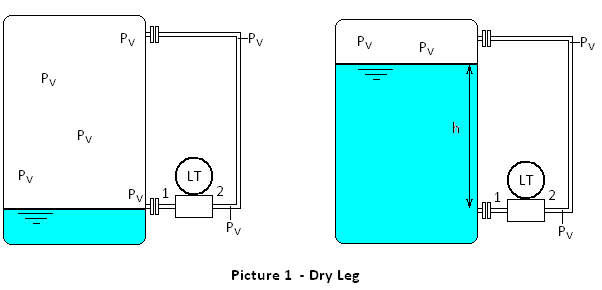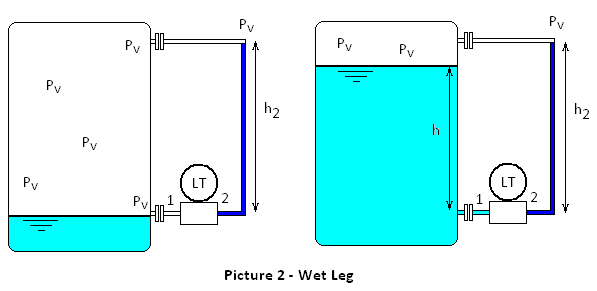Determining range of DP level transmitter installed on an atmospheric tank has been discussed previously in another post. This section tries to describe the DP level transmitter installation on pressurized vessel.
Unlike atmospheric tank, the pressure vessel is an enclosed container in which has vapor pressure exerting over the liquid and the value of the vapor pressure may vary along the time.
The vapor pressure can not be neglected hence it should be measured by both ports of DP level transmitter. This could be accomplished by routing the vapour pressure into the port (2) using an impulse line.
There are two methods for this installation: dry leg and wet leg. The selection between both of them is depend on the vapor properties.
Dry leg is applied if there is no possibility of vapor condensation. Upper tapped leg will always dry, no liquid would fill the upper tapped leg. In this case, no additional liquid pressure will exert port (2) other than the vapor pressure. Hence, Port (2) only measures the vapor pressure (see picture 1).
DP Level Transmitter - Dry Leg

Wet leg is applied in system where the vapor is easy to condense. The condensation would fill the leg and subsequently will be accumulating on port (2) side which means adds additional pressure resulted from condensate hydrostatic force.
If it is expected such condition will occur, the high tapped leg shall be fully filled by chemically inert liquid that will not freeze or vaporize under operating temperature conditions so the pressure exerted by the liquid in port (2) has been anticipated and taken into account as constant pressure in the calculation on determining the calibrated range (see picture 2).
DP Level Transmitter - Wet Leg

However, most application prefer to use DP level transmitter with combination of capillary tube and diaphragm seal as it offers less maintenance. The calculation will be discussed in another post.